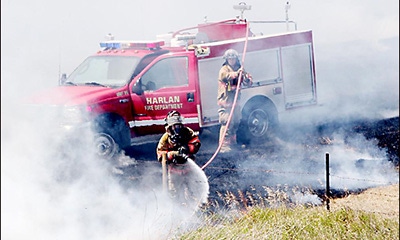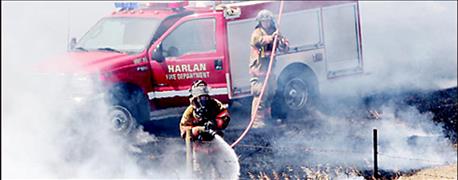
Strong winds, low humidity and lots of dry cornstalks and soybean crop residue are a recipe for field fires. A spark from an engine exhaust can quickly ignite the material. Farmer Jordan Uthe experienced that situation on Monday in a cornfield near Boone in central Iowa. "It doesn't take much to start a fire, especially with this wind," he notes. "And the fire travels fast."

OUR FIELD IS ON FIRE!: Dozens of field fires have popped up across Iowa in recent days. A fire on Monday near Harlan in western Iowa required five local fire departments to contain it. A number of counties in Iowa are under a burn ban until the area receives some rain.
Uthe was fortunate. The fire in his field was contained before it got out of hand. This was just one of many blazes firefighters have fought in fields around the state in recent days. Near Colo in Story County, a fire rapidly spread across a field but the local fire department was able to put it out before it spread to a nearby house.
Farmers like warm weather but could do without the wind
"This warm and windy weather we're having this fall is good for everything other than fires. The corn is nice and dry coming out of the field and harvest has been moving right along," says Uthe.
Burn bans have been in place in a number of counties in Iowa for the past week or so. And burning anything outdoors is being discouraged. Winds of up to 35 mph were reported across the state Monday, and a red flag warning was in effect by the National Weather Service.
Clarke McGrath, an Iowa State University Extension field agronomist at Harlan in western Iowa, was a volunteer firefighter with the Harlan Fire Department for many years. He and ISU Extension ag engineer Mark Hanna offer the following advice on preventing field fires and combine fires given continued dry and windy conditions.
Advice on preventing/managing field fires and combine fires
It's always difficult to forecast weather, but if dry field conditions persist, potential for combine and field fires this fall will continue to be a problem. "There have already been dozens of significant field fires around the state," says McGrath, "including a fire yesterday near Harlan that required five departments to contain. All it can take is a single high-temperature source in the engine area. Even an overheated bearing can ignite dry plant material."
During harvest periods with increased fire potential, fires cause millions of dollars in property damage in Iowa, including loss of machinery, crops and time. Injuries to farm workers and firefighters are also an unfortunate outcome in some instances, adds Hanna. "Modern, high-productivity combines are powerful machines, and power means heat. Fire cannot start without heat and fuel. You cannot remove the heat from the engine, hydraulics and other hardworking systems, but you can remove the fuel source by keeping your combine clean."
Prevention is a key to avoiding problems; here are some tips:
•Keep the machine clean, particularly around the engine and engine compartment. Use a high-pressure washer or compressed air to remove caked-on oil, grease and crop residue.
•Check coolant and oil levels daily.
•Check the pressurized oil supply line to the turbocharger for wear areas that rub and may start an oil leak.
•Frequently blow leaves, chaff and plant material from the engine area with compressed air or a portable leaf blower. Doing this one last time at night is better than in the morning when dew may make it harder to blow residues off.
•Remove plant materials wrapped on or near bearings, belts or other moving parts.
•Examine exhaust or hot bearing surfaces. Repair leaking fuel or oil hoses, fittings or metal lines immediately.
•Inspect and clean ledges or recessed areas near fuel tanks and lines.
•Prior to fueling, wait 15 minutes to reduce the risk of a spill volatilizing and igniting.
Hanna and McGrath also offer these three additional recommendations for farmers and other workers to keep in mind.
1. In case of fire, call 911 first. And then attack it with fire extinguishers if it is safe to do so. Try to fight from the "black", the area already burned; attacking a fire from field areas with combustibles (stalks for example) is much riskier.
2. A fire can double in size in less than a minute. Burning embers blown downwind can spread the fire well beyond the control of your fire extinguishers in just seconds. Two ABC-type fire extinguishers are recommended to have handy on your combine: a smaller 10-pound unit in the cab, and a larger 20-pound extinguisher mounted on the combine so you can reach it at ground level.
3. Invert and shake the extinguishers once or twice during the harvesting season. That will ensure machine vibrations don't compact the powder inside. Having a shovel handy to throw dirt on a fire can also help.
Fires may start from plant materials that have smoldered unnoticed for 15 to 30 minutes or more. The ignition source for field fires may have been the earlier passing of a truck, tractor or combine. Flames aren't apparent until additional oxygen is supplied, perhaps by a gust of wind. Harvest crews and neighbors may want to discuss a plan for emergency tillage of a fire break should that option become advisable.
Final thought: Keep in mind that personal safety is more important than property loss. Good luck and stay safe as we enter the home stretch of harvest.
About the Author(s)
You May Also Like




